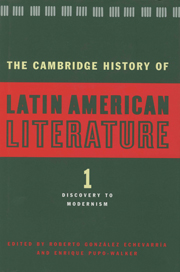Book contents
- Frontmatter
- Introduction to Volume 1
- 1 A brief history of the history of Spanish American Literature
- 2 Cultures in contact: Mesoamerica, the Andes, and the European written tradition
- 3 The first fifty years of Hispanic New World historiography: the Caribbean, Mexico, and Central America
- 4 Historians of the conquest and colonization of the New World: 1550–1620
- 5 Historians of the colonial period: 1620–1700
- 6 Colonial lyric
- 7 Epic poetry
- 8 Spanish American theatre of the colonial period
- 9 Viceregal culture
- 10 The eighteenth century: narrative forms, scholarship, and learning
- 11 Lyric poetry of the eighteenth and nineteenth centuries
- 12 Spanish American theatre of the eighteenth century
- 13 The nineteenth-century Spanish American novel
- 14 The brief narrative in Spanish America: 1835–1915
- 15 The Spanish American theatre of the nineteenth century
- 16 The essay in Spanish South America: 1800 to Modernismo
- 17 The essay of nineteenth-century Mexico, Central America, and the Caribbean
- 18 The gaucho genre
- Index
- Bibliographies
- References
4 - Historians of the conquest and colonization of the New World: 1550–1620
Published online by Cambridge University Press: 28 March 2008
- Frontmatter
- Introduction to Volume 1
- 1 A brief history of the history of Spanish American Literature
- 2 Cultures in contact: Mesoamerica, the Andes, and the European written tradition
- 3 The first fifty years of Hispanic New World historiography: the Caribbean, Mexico, and Central America
- 4 Historians of the conquest and colonization of the New World: 1550–1620
- 5 Historians of the colonial period: 1620–1700
- 6 Colonial lyric
- 7 Epic poetry
- 8 Spanish American theatre of the colonial period
- 9 Viceregal culture
- 10 The eighteenth century: narrative forms, scholarship, and learning
- 11 Lyric poetry of the eighteenth and nineteenth centuries
- 12 Spanish American theatre of the eighteenth century
- 13 The nineteenth-century Spanish American novel
- 14 The brief narrative in Spanish America: 1835–1915
- 15 The Spanish American theatre of the nineteenth century
- 16 The essay in Spanish South America: 1800 to Modernismo
- 17 The essay of nineteenth-century Mexico, Central America, and the Caribbean
- 18 The gaucho genre
- Index
- Bibliographies
- References
Summary
Introduction
Who were the historians writing about the conquest and colonization of Spanish America after the mid sixteenth century? What is their importance to a history of Spanish American literature? How may a history of historiography go about portraying the literary currents of an era? This essay will address these questions, with the goals of making new voices heard and of listening to old ones in new ways. Any study that attempts to sum up seventy years of written history must pick and choose from among many sources, and will of necessity be informed by the critical thought of its own time. As we approach the period 1550-1620, however, some problems specific to this era and its literature come into play. Their definition is in and of itself an important part of this literary history, and is thus the initial matter to which we turn our attention.
The first of these problems has to do with the relationship between text and culture. The discussion of texts here will be complemented with a description of their extra-textual surroundings during the years in question; this is done with the conviction that the writing of the period was not a mere reflection of its milieu, but rather that it engaged the outside culture and indeed was instrumental in its creation. Matters are complicated for the years 1550-1620, however, by the fact that while some texts were published upon completion or shortly thereafter, others were not in print until hundreds of years later, principally the nineteenth century.
- Type
- Chapter
- Information
- The Cambridge History of Latin American Literature , pp. 101 - 142Publisher: Cambridge University PressPrint publication year: 1996



